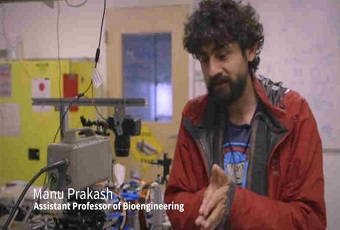Manu Prakash, an Indian-origin scientist, who is also credited with the discovery of the paper microscope, only last year, has once again stunned the world by developing the World’s first water-based computer along with his team, as published in the journal Nature Physics.
Using Prakash’s know-how in manipulating droplet fluid dynamics with a fundamental element of every computer – an operating clock, which is responsible for the working of smartphones to airplanes (Every application requires several concurrent operations, to be conducted in an accurate step-by-step manner, and this is handled by the clock, which makes sure that these operations start and stop at the same time, thus ensuring that the information synchronizes), they have come up with this next gen computer. He used the tiny water droplets, trapped in a magnetic field, as the basis of the clock (when the field is rotated or flipped, the droplets move in precise direction and distance).
To make the system scalable, so that in the future, a large number of droplets could communicate amongst each other effortlessly, they used a rotating magnetic field. The current chips are about half the size of a postage stamp. Katsikis and Prakash built arrays of tiny iron bars on glass slides. They laid a blank glass slide on top and sandwiched a layer of oil in between. Then they carefully injected into the mix, individual water droplets using tiny magnetic nanoparticles. As the magnetic field is turned on, the polarity of the bars reverses, everytime the field flips, drawing the magnetized droplets in a new, preset direction. Every rotation of the field counts as one clock cycle, and every drop marches exactly one step forward with each cycle. A camera records the interactions between individual droplets, allowing observation of computation as it occurs in real time. The presence or absence of a droplet represents the 1s and 0s of binary code, and the clock ensures that the entire droplets move in perfect synchrony, and thus the system can run virtually forever without any errors.
The droplet computer can tentatively perform any operation that a conventional electronic computer can, but at very slower rates. But the ability to specifically control droplets using fluidic computation has made its immediate application possible in a high-throughput chemistry and biology laboratory, where, instead of running reactions in bulk test tubes, each droplet can carry some chemicals and become its own test tube. It also has much scope in scalable digital manufacturing.
Manu Prakash is an Assistant Professor of Bioengineering at Stanford University. He was born in Meerut.





